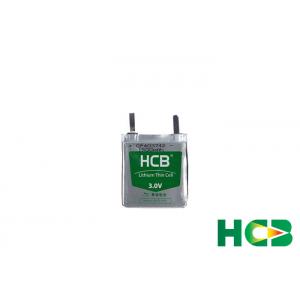
Add to Cart
Excellent Safety Lithium Primary Battery Nominal Voltage 3.0V CP403742
| Nominal Capacity | 1400mAh |
| Battery discharged at continuous current 1mA until voltage reaches cut-off voltage 2.0V at ambient temperature 23±2℃ | |
| Nominal Voltage | 3.0 V |
| Maximum Continuous Current | 600mA |
| Battery with minimum 50% rated capacity discharged at ambient temperature 23±2℃ | |
| Maximum Pulse Discharge Current | 1000mA |
| Battery with minimum 50% rated capacity discharged at max pulse for 3 seconds after 27seconds break. Ambient temperature 23±2℃ | |
| Storage Condition | Temperature ≤ 30℃ Humidity ≤ 75%RH |
| Operating Temperature | -40℃ to +60℃ |
| Battery Dimension | See drawing on pag |
| Max Weight | 13.0g |
| Self-discharge Rate | 2% |
| Max self-discharged rate at ambient temperature 23±2℃ | |
| Shelf Life | 10 years |
| Ambient temperature 23±2℃ | |
1. Battery Characteristic
We provide the nominal voltage up to 3.0V
We provide the specific energy density up to 323Wh/kg, 50% higher than the steel-shelled lithium cell of the same weight
Battery working temperature range from -40℃ to +60℃
The battery self-discharge less than 2% per year at room temperature
There is no voltage passivation problem, also need not activated after long time storage, install-and-play, ultra-high maintenance-free features
To meet the requirements of modern light & handy electronic products
Dimensions can be customized according to different demands, short product development period, meeting customers’ varieties of personalized needs
The most reliable cell with the best safety performance; able to bear cruel tests without any protection such as short circuit, puncturing, etc.
2. Main Applications
Automatic meters (water meter, electric meter, gas meter), conventional meters, etc.
Wireless telecommunication devices
Well pressure meters in high temperature, float meter, logging while drilling (LWD), measure while drilling (MWD), etc.
3. Manufacturing Advantages
4. Company Advantages
5. FAQS of General Safety Instructions
During the batteries disposal, you need to follow the local and state regulations.
If you charge the primary batteries, it can lead to toxic material or gas leakage and maybe cause big rupture or fire.
The batteries of different electrochemical system, grades, or brands can’t be mixed because it would lead toxic material or gas leakage and/or a big rupture.
Do not deform the batteries. Batteries are not to be crushed, drilled into or damaged in any other way. This can lead to toxic material or gas leakage or/and violent rupture.
You need to follow the signs + and - on the batteries and make sure not to reverse. If batteries are wrongly used, they will be hot very fast and can lead the gas and other toxic materials leakage.
Keep battery out of the children. If swallowed, please contact a physician at once.
We need to stop using the battery when the abnormal heat release or leakage occurs.
